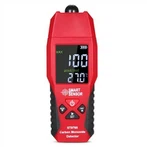Infrared thermometer usage and common sense
Since the infrared thermometer will be interfered by factors such as weather environment and improper human operation during use, it will directly affect the screening of fever personnel. In order to ensure that the supervisors of checkpoints, merchants, bazaars, medical institutions, factories, and schools can effectively play the role of infrared thermometers during the epidemic period in the region, effectively guide the public to use thermometers in a scientific and standardized manner, and help our district resume work and production. Screening of returning students, and introducing and publicizing their use methods to users.
What is an infrared thermometer: It uses the front-end infrared machine to identify high-temperature people, with high identification efficiency, and realizes the face-assisted temperature sensing of non-contact intensive people to solve the efficiency and controllability of public places.
1. Infrared thermometers cannot measure temperature through glass. Glass has very special reflection and transmission characteristics, which does not allow accurate infrared temperature readings. However, the temperature can be measured through the infrared window. Infrared thermometers should preferably not be used for temperature measurement on shiny or polished metal surfaces (stainless steel, aluminum, etc.).
2. Infrared thermometers can only measure the surface temperature of an object, not its internal temperature.
3. Locate the hot spot carefully, find the hot spot, use it to aim at the target, and then scan the target up and down until the hot spot is determined.
4. When we use it, we should pay attention to the environmental conditions: smoke, steam, dust, etc. They can block the optical system of the instrument and affect accurate temperature measurement.
5. When using an infrared thermometer, also pay attention to the ambient temperature. If it is suddenly exposed to an ambient temperature difference of 20 degrees or higher, allow the instrument to adjust to the new ambient temperature within 20 minutes.
When using an infrared thermometer to measure temperature, the infrared energy emitted by the measured object will be converted into an electrical signal on the detector through the optical system of the infrared thermometer, and the temperature reading of the signal will be displayed. Important factors for temperature measurement, the most important factors are emissivity, field of view, distance to the spot and location of the spot. Emissivity, all objects reflect, transmit and emit energy, only the emitted energy can indicate the temperature of the object. When an infrared thermometer measures surface temperature, the instrument receives all three of these energies. Therefore, all infrared thermometers must be adjusted to read only the energy emitted. Measurement errors are often caused by reflected infrared energy from other light sources. Some infrared thermometers can vary emissivity, and emissivity values for many materials can be found in published emissivity tables. The other instruments have a fixed emissivity of 0.95. This emissivity value is for the surface temperature of most organic materials, painted or oxidized surfaces, and is compensated by applying a tape or flat black paint to the surface being tested. When the tape or paint is brought to the same temperature as the base material, measure the temperature of the surface of the tape or paint, which is its true temperature. The ratio of distance to spot, the optical system of the infrared thermometer collects energy from the circular measuring spot and focuses it on the detector, and the optical resolution is defined as the ratio of the distance from the infrared thermometer to the object to the size of the spot being measured (D :S). The larger the ratio, the better the resolution of the infrared thermometer and the smaller the spot size to be measured. Laser aiming, only to aid aiming at the measuring point. The latest improvement in infrared optics is the addition of a near focus feature that provides accurate measurement of small target areas and prevents the effects of background temperature. Field of view, make sure the target is larger than the spot size measured by the infrared thermometer, the smaller the target, the closer it should be. When accuracy is particularly important, make sure the target is at least 2 times the spot size.






